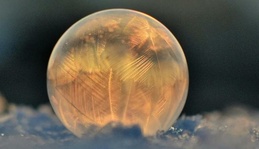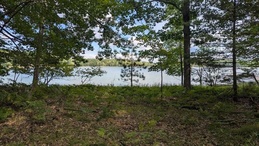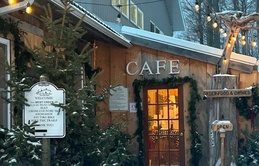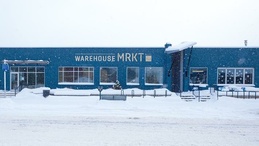
Did You Know We're Known for THAT?! Here's What 7 Spots Up North Are (Somewhat) Famous For
From important soil to portals to hell to pirate kings, NoMi has some out-there attractions and histories
By Rachel Pasche | May 25, 2024
Everyone knows Traverse City is famous for the Cherry Festival. Leelanau is home to Sleeping Bear Dunes. Mackinac Island has great fudge. But what about some of those lesser-known attractions? The cool, quirky, or downright weird things that define our northern Michigan towns? Let’s find out what some of our friends and neighbors are known for…at least among those in the know.
Benzie County: Home to Only One Stoplight
A drive through most cities and towns will guarantee multiple red lights along the way, but in Benzie County, you’ll have to take a specific route to hit the region’s lone stoplight.
Benzie County is home to Benzonia, Frankfort, Beulah, Honor, Thompsonville, Elberta, Lake Ann…and one stoplight between all those towns. The stoplight sits at the intersection of US-31 and M-115, though the possibility of adding more has been discussed.
“Benzie County’s many small towns have speed zones as low as 25 miles per hour within a downtown district as well as many ordinances regarding pedestrian crossings [much like Traverse City’s Front Street]," says Michelle Barefoot, executive director of the Benzie Area Chamber of Commerce. "Unfortunately, with the influx of visitors in the summer months, these ‘slow zones’ are often disregarded.”
If you’re driving through Benzie County this summer, remember to slow down, and don’t get too upset if you hit the red light!
Kalkaska: Home of the Official State Soil
Michigan boasts over 500 different types of soils, but the state soil is Kalkaska Sand.
First identified in 1927, Kalkaska Sand consists of multiple layers of soil, including light sand, yellowish sand, dark sand, and humus, ranging in color from reddish brown to yellow to black. This soil filters water well, and is said to be partly responsible for the water quality of the lakes and rivers in regions where it’s found.
The water filtration and well-draining nature of Kalkaska Sand also make it important to agriculture and forestry, which were important considerations when deciding what the state soil should be in 1990. The designated soil needed to support a state crop (white pine) and be widespread (Kalkaska Sand covers nearly 1 million acres across both peninsulas). Kalkaska Sand meets both requirements, and is a unique element of our state.
Traverse City: Home to the Hippie Tree (or a Portal to Hell)
In the woods near the Village at Grand Traverse Commons grounds in Traverse City is an area that’s been visited and decorated by thousands of people for generations. The Hippie Tree is more than a single tree and more closely resembles something out of a Disney film: a tucked away space with large fallen trees and smaller trees surrounding it, all painted and decorated in bright, beautiful colors. The end result is a dazzling display that feels otherworldly.
Some folks take that otherworldly aura literally, and explanations for the draw of the grove include that it’s a portal to hell, haunted by spirits, and/or is a spot for supernatural encounters. Legends say the spirits rumored to haunt the place are disquieted shades of previous residents of the Northern Michigan Asylum/Traverse City State Hospital. To visit the Hippie Tree and decide for yourself whether it’s a place of good or evil, park in the lot near Greenspire School and head up the trail, taking the right at the fork and then the first left.
Kaleva: Home of the Bottle House
In the small town of Kaleva is the Bottle House, a home constructed of over 60,000 glass bottles that serve as the primary exterior walls.
John Makinen immigrated to Kaleva from Finland in 1903 and opened a local bottling company, Northwestern Bottling Works Co., from which he sourced the materials for his project. It’s rumored that he used chipped, defective, and surplus bottles to build his house, using a technique he developed in 1932 to mortar and stack the bottles to create the walls. Makinen finished the house in 1941 and passed away a year later, never able to live in his glass home, though his family resided there for nearly 40 years.
“Over the years, there was one instance of vandalism and a few bottles displaced. Where they have been repaired is obvious because Mr. Makinen's secret mortar formula couldn’t be replicated. For the most part the bottles have held up over the 80 years since construction,” Cynthia Asiala, president of the Kaleva Historical Society, tells us.
Today, the Historical Society owns and maintains the museum. Tours are given upon request.
Petoskey: Home of the Underwater Crucifix
Offshore beneath the waves near Petoskey lies an 11-foot-tall crucifix made of Italian white marble, the only known underwater crucifix found in freshwater.
The marble statue was carved in Italy in the 1950s at the order of a couple in Rapson, Michigan, who had it crafted to commemorate their son who had passed in a tragic accident the year prior. When the marble arrived broken, having cracked in transit, the couple no longer wanted it, and it was sold to the Wyandotte Dive Club. Eventually, the crucifix made its way to the Petoskey area, where it was placed in the water in 1962 to honor Charles Raymond, a diver who drowned in Torch Lake, and later the focus grew to memorialize all those who have perished at sea.
Visitors and divers in the area can visit the monument; divers in the warmer months, and visitors during the “Viewing of the Crucifix” that takes place each winter, where a hole in the ice and lights placed on the monument allow easy visibility of the marble.
Charlevoix: Home of a Floating (Now Sunken) Speakeasy
There are few things more enjoyable than sipping an adult beverage on a boat during a northern Michigan summer, a sentiment that stayed true during Prohibition times. If we were to guess, that’s why Captain James Gallagher transformed an old lumbar barge into Lake Charlevoix’s hottest speakeasy, the Keuka.
On New Year’s Eve of 1929, the Keuka was opened to the public as a dance hall on the water, advertising music and a roller rink as a cover for the illicit drinking and casino activities that were really taking place. Passengers would line up on the dock in Charlevoix, where they were ferried out to the middle of Lake Charlevoix and the facade removed.
“The Keuka wasn’t just related to Charlevoix … it made its way up and down Lake Charlevoix to Boyne City, where it was frequently docked, and I am sure now and then toward East Jordan,” says Trevor Dotson, manager of operations at the Charlevoix Historical Society.
“There is no factual evidence as of today that Al Capone was ever on the boat or had anything to do with the boat and the speakeasy. That myth just keeps getting perpetuated,” Dotson adds, alluding to the rumors that Capone was involved with the operations on the Keuka.
The barge remained in and out of operation until it mysteriously sank in 1932. The wreck can be visited by divers, and there is a Keuka exhibit at the Museum at Harsha House in Charlevoix.
Beaver Island: Home of the County’s Only King
Did you know the United States once had a king? Well, sort of: James Jesse Strang was a religious leader and self-proclaimed king who based his operations out of Beaver Island.
Strang thought himself to be a prophet and the successor to Joseph Smith, the founder of Mormonism and the Latter-day Saints movement. He gathered a following that went with him to Wisconsin and later Beaver Island, and in the late 1840s, he established the settlement of St. James on Beaver Island’s northern coast. Strang held a coronation for himself in July of 1850, naming himself King James I. His was an ecclesiastical reign rather than a geographical one, but it did lead to trouble with the law and the people and militias living nearby.
Though not buccaneers in the typical sense, Strang’s followers accrued notoriety around northern Michigan for their ruthless antics on the island—namely taking goods and land from the island’s occupants—and were deemed pirates by the local press. Strang faced trial in Detroit for various crimes during his reign—including theft, treason, and trespassing—but was not convicted. Instead, Strang was twice elected into the Michigan House of Representatives, serving from 1853 to 1856, furthering his power. (An ironic but perhaps unsurprising twist for us 21st-century cynics.)
His reign ended when he was shot by two former followers in 1856, after which Beaver Island’s populace drove out the remaining Strangites and dismantled the sect.
Trending

Welcoming the Winter Solstice: Rituals & Events for the Shortest Day of the Year
With the winter solstice quickly approaching, it’s hard not to notice how dark each day feels. Astronomically, this is… Read More >>
Camp Greilick Now Open!
It’s been a long road for the century-old Camp Greilick, which, after several dormant years, was acquired by Grand Tra… Read More >>
Men and Ugly Sweaters
Those two things don’t always go together, but on Dec. 19, you’ll see both out and about in Petoskey and Harbor … Read More >>


